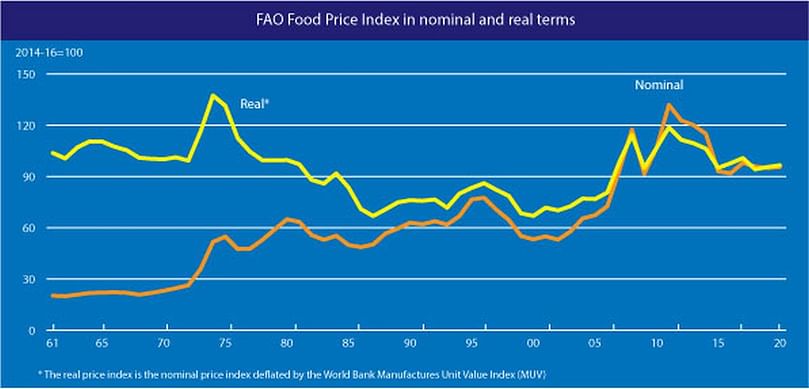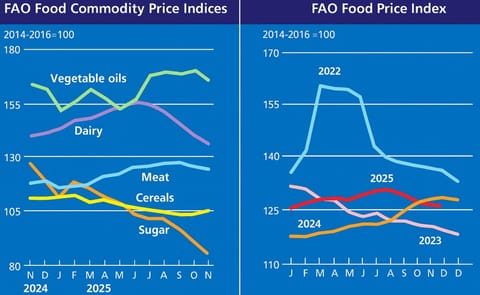The FAO Food Price Index rebounds in June
The FAO Food Price Index rebounds in June

The FAO Food Price Index* (FFPI) averaged 93.2 points in June 2020, some 2.2 points (2.4 percent) higher than in May, representing the first month-on-month increase since the beginning of the year.
Amid market uncertainties posed by COVID-19, the prices of vegetable oils, sugar, and dairy products rebounded to multi-month highs following sharp declines registered in May, while in cereals and meat markets, most prices remained under downward pressure.
The FAO Cereal Price Index averaged 96.9 points in June, down marginally (0.6 percent) from May and 1.9 points (1.9 percent) below the corresponding month last year.
Downward pressure on wheat prices intensified in June, in part due to new harvests in the northern hemisphere, but also due to improved production prospects in a number of major exporting countries, in particular in the Black Sea region.
Slow trading activities and currency movements in selected exporters caused international rice prices to register their first, albeit mild, decline since the start of the year.
Barley and sorghum export prices also fell in June, reflecting generally good production prospects amid timid global import demand.
By contrast, following several months of decline, maize price quotations were firmer in June, supported by some recovery in demand and adverse growing conditions in the US.
The FAO Vegetable Oil Price Index averaged 86.6 points in June, gaining 8.8 points (or 11.3 percent) after declining for four consecutive months. The rebound of the Index mainly reflects higher palm oil values, while quotations of soy, sunflower, and rapeseed oils also appreciated.
International palm oil prices rose sharply in June on account of both recovering global import demand, following the easing of COVID-19 related lockdowns in numerous countries, and concerns over possible production setbacks amid prolonged migrant labor shortages.
While reviving global demand also lent support to other vegetable oils, soy and sunflower oil prices responded to limited export availabilities in leading exporting countries. In the case of rapeseed oil, recovering demand from the EU’s biodiesel industry also underpinned prices.
The FAO Dairy Price Index averaged 98.2 points in June, up 3.8 points (4.0 percent) from May. June marked the first increase in the value of the Index after four months of consecutive declines, even though the Index remained 4.6 percent below its level in the corresponding month of 2019.
Price quotations for all the dairy products represented in the Index rose, but not to the pre-pandemic levels.
Renewed import demand for spot supplies, especially from the Middle East and East Asia, coupled with seasonally declining supplies in Europe and limited availability of uncommitted supplies in Oceania, underpinned the recent price increases.
The FAO Meat Price Index** averaged 95.2 points in June, down marginally (0.6 percent) from May and 6.1 points (6.0 percent) below its June 2019 level. International price quotations for poultry and bovine meats fell, largely due to increased export availabilities in major producing regions, despite high import orders from China and the Middle East. By contrast, pig meat prices made a small recovery, mostly driven by a timid recovery in Europe on the expectation of the easing of COVID-19 market restrictions. Ovine meat prices made stronger gains as demand for herd building led to a tightening of supplies from Oceania amid consistently high import demand.
The FAO Sugar Price Index averaged 75.0 points in June, up 7.2 points (10.6 percent) from May.
The surge in crude oil prices provided strong support to sugar markets; it encouraged Brazil’s sugar mills to use more sugarcane supplies to produce ethanol instead of sugar, thereby affecting sugar export availabilities.
Furthermore, recent reports of bottlenecks in Brazilian ports due to the measures imposed to contain the spread of the coronavirus helped in pushing up the value of the Sugar Price Index.









